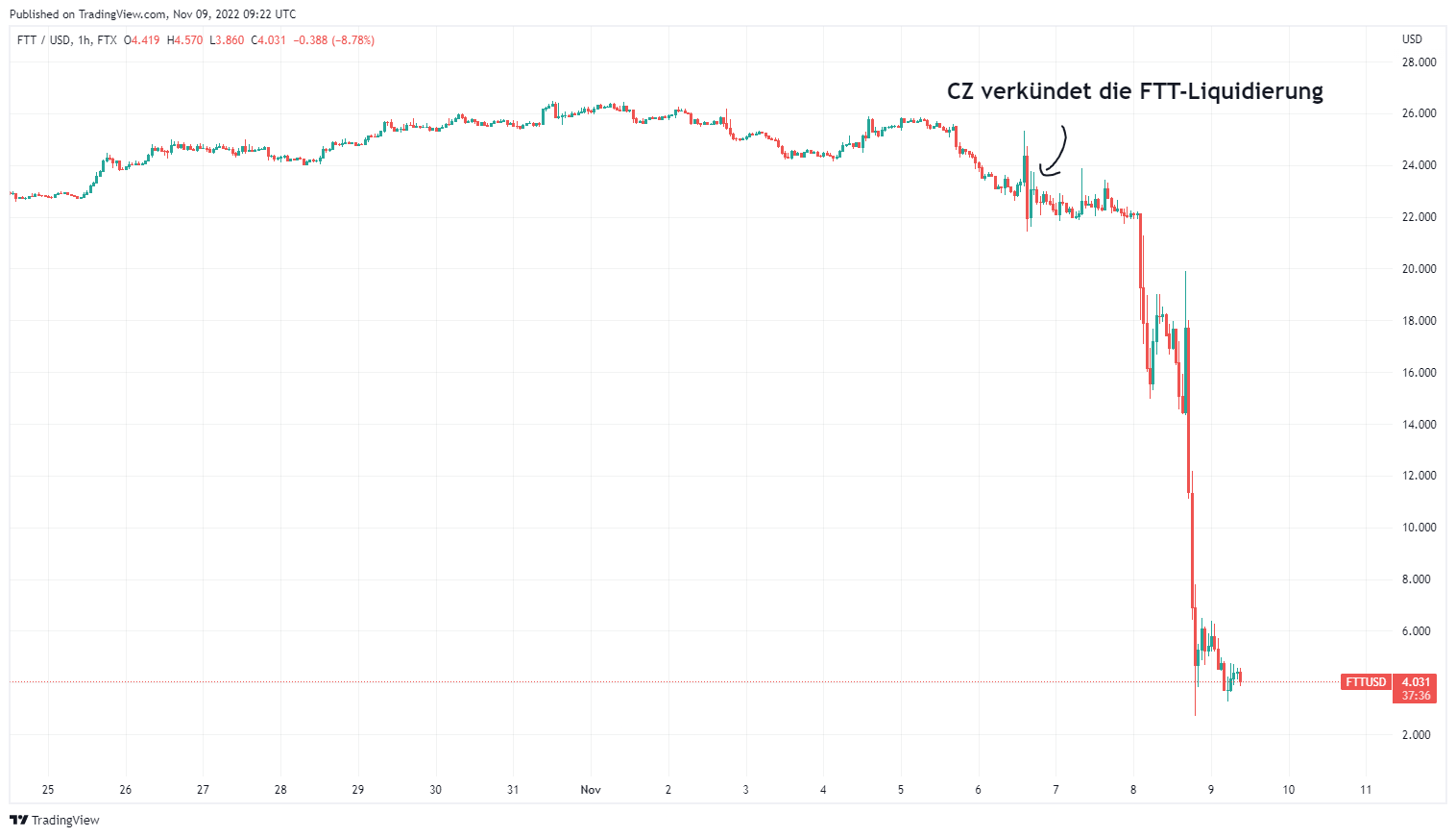Just a few months after the Three Arrows debacle, the next billion-dollar player is floundering. The crypto exchange FTX and its largest market maker Alameda Research reveal a weighty hole in their balance sheet after a long back and forth with Binance. Now, insolvency and a potential takeover loom.
Crypto exchange FTX has had an impressive history. Founded only in 2019 "for traders, by traders," founder Sam Bankman-Fried (aka SBF) managed a rapid rise to the top 3 crypto trading exchanges, second only to the success story of Binance (founded in 2017, as of 2019 the highest volume crypto exchange). Add to that a highly profitable bull market for Alameda Research, a trading house also founded by SBF. But ironically, Bankman-Fried is now following in the footsteps of the insolvent companies (Voyager, Celsius, etc.) that he was proudly injecting with liquidity just a few months ago.
Update 11.10.2022: After only one day, Binance withdrew their offer; the damage had been greater than expected. According to the WallStreetJournal, the uncovered amount on FTX's balance sheet amounts to roughly USD 8 billion. An anonymous Reuters source suggests that at least USD 4 billion of that was lent to Alameda Research. This included client funds.
Update 11.11.2022: The crypto exchange ranked among the 3 largest has filed for bankruptcy with unfunded liabilities totaling more than $10 billion. This is by far the largest bankruptcy in the US this year, affecting investors and other counterparties around the world. Sam Bankman-Fried is stepping down as FTX Group's Chairman and CEO. Even in the world of cryptocurrency, where numerous companies have risen and fallen, FTX's bankruptcy is an extraordinary situation due to its magnitude.
Alameda and FTX: a controversial relationship
To understand the current situation, some background on the history of SBF's ventures is important. Namely, the former Jane Street trader ventured into the crypto markets only in 2017 - rather late compared to other successful figures in the industry. Experienced with arbitrage trading from the traditional financial world, Bankman-Fried recognized great potential in the still young and inefficient crypto industry. Thus, he founded his own quantitative trading firm, Alameda Research, in the same year. The company initially started with arbitrage trading between centralized exchanges, but quickly expanded its area of expertise into market making and VC investing.
After two successful years, the then 27-year-old entrepreneur was ready to launch his own exchange. A strategic investment from Binance, already the leading crypto exchange at the time, allowed FTX to establish itself early on as an innovator in the derivatives market space. With Alameda Research as a market maker, ample liquidity was provided. Everything seemed to be going perfectly for Bankman-Fried. His trading house grew into the double-digit billions, FTX was soon battling with Coinbase for second place among crypto exchanges, and thanks to clever moves in the U.S. lobby landscape, SBF also exerted its influence politically.
The FTT token becomes a doom
This seemingly flawless track record was first called into question a week ago. A leaked document exposed Alameda Research's balance sheet, revealing a highly indebted company with billions of dollars in outstanding loans against the FTX exchange token FTT. Some $8 billion in debt was offset by $14.6 billion in assets, of which about $6 billion was invested in FTT and $3.3 billion in Solana tokens. Bad memories of the Three Arrows debacle resurfaced.
Although the document was labeled "outdated" and "inaccurate" by both SBF and Alameda Research CEO Caroline Ellison, it caused many market participants to frown. Among them was one of its earliest investors and founder of rival crypto exchange Binance, Changpeng Zhao (aka CZ). Less than a week after the aforementioned document was circulated, the Binance CEO announced that their venture arm would sell the $500 million in remaining FTT. The decision was attributed to "recent revelations."
As part of Binance’s exit from FTX equity last year, Binance received roughly $2.1 billion USD equivalent in cash (BUSD and FTT). Due to recent revelations that have came to light, we have decided to liquidate any remaining FTT on our books. 1/4
— CZ 🔶 BNB (@cz_binance) November 6, 2022
The beginning of the end
Just two days later, the fears were to come true. Users began making mass withdrawals from FTX in the billions, and FTX was forced to stop withdrawals of larger sums. Panic set in. An initial collapse wiped out 30% of FTT's market value, and a liquidation spiral of 80% occurred a few hours later.

As the consistent collapse of the entire market proved (Bitcoin -16% in 4h), SBF's construct was struggling for liquidity. What was dismissed as a rumor a few days ago proved to be reality within a painful short time. Another highly profitable crypto empire imploded due to massive over-leveraging. Unfortunately, not only SBF's ventures are affected, but once again thousands of customers are threatened with total loss. The motto "not your keys, not your coins" proves true once again.
Binance considers full takeover
Then comes the first official statement from Bankman-Fried. He confirmed the liquidity problems of his crypto exchange and announced a potential sale of FTX. He said that an agreement with Binance was in the offing, which included a complete takeover. The first, and now possibly last, FTX investor would be central to addressing the current liquidity shortages. However, the transaction is in early stages and could be withdrawn after the upcoming due diligence.
This afternoon, FTX asked for our help. There is a significant liquidity crunch. To protect users, we signed a non-binding LOI, intending to fully acquire https://t.co/BGtFlCmLXB and help cover the liquidity crunch. We will be conducting a full DD in the coming days.
— CZ 🔶 BNB (@cz_binance) November 8, 2022
FTX's bankruptcy illustrates lack of transparency of crypto exchanges
How big the hole in FTX's balance sheet is remains to be seen. Also, not much more is known yet about the situation of Alameda Research. But the incident demonstrates the actual use case of the crypto industry once again. Intransparent, centralized financial constructs will always remain vulnerable as long as human parties are involved.
It was this very circumstance that led Satoshi Nakamoto to bring out Bitcoin in 2008. However, the same causes of bank crises have been repeated over the past few months within the crypto sector. Suspect handling of customer funds coupled with high-risk leveraged investments have brought even the largest crypto institutions to their knees in times of stress. The industry needs a clear regulatory framework for crypto companies that hold customer assets. In particular, the handling and transparency of managed customer assets must be consistently defined in order to avoid cases like FTX and Co. in the future.




